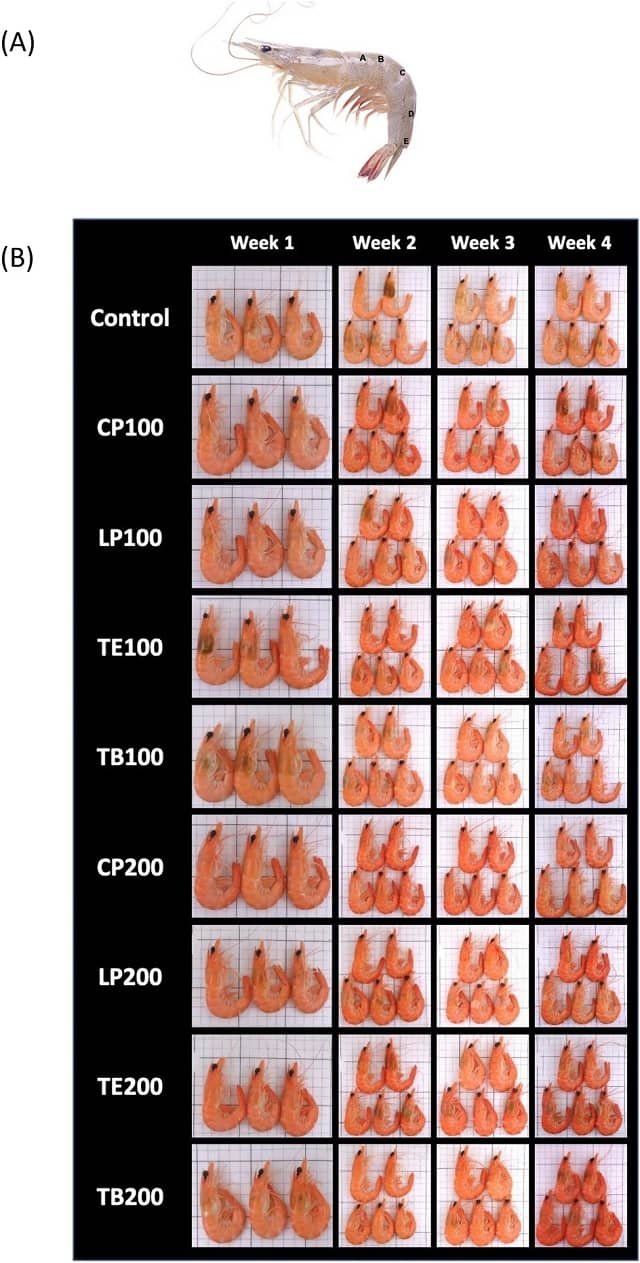
As the shrimp farming industry expands, there is an increasing emphasis on sustainable practices that prioritize the health, quality, and environmental impact of shrimp. In this context, ensuring healthy shrimp growth and optimal nutritional value requires continuous research. A recent study published in the Open Access Library Journal investigated the impact of new ecological technologies in the farming of Penaeus vannamei.
The research, led by scientists from the Zhoushan Fisheries Research Institute of Zhejiang and the Hainan Tropical Ocean University, studied the use of ecological methods in the aquaculture of Penaeus vannamei (whiteleg shrimp). The study compared the effects of these methods with traditional techniques across several aspects of shrimp health and quality.
The Importance of Nutrition in Shrimp Farming
- 1 The Importance of Nutrition in Shrimp Farming
- 2 Innovative Approaches to Shrimp Farming
- 3 Case Study: Zhoushan Fisheries Research Institute of Zhejiang
- 4 Improved Growth and Muscle Quality
- 5 Benefits of Ecological Aquaculture Texture
- 6 The Role of Ecological Materials
- 7 Sustainable Practices for a Thriving Industry
- 8 Conclusion
- 9 Entradas relacionadas:
The nutritional content of shrimp is influenced by various factors, including diet and specific farming techniques employed. Studies have shown that the fatty acid composition of shrimp feed plays a crucial role in determining the quality and health of shrimp muscle tissue. Additionally, the shrimp’s gut microbiota, influenced by diet and beneficial bacteria, plays a vital role in nutrient absorption and energy storage.
Innovative Approaches to Shrimp Farming
To address the challenges associated with traditional shrimp farming methods, researchers and aquaculturists are exploring innovative approaches. One such approach involves using insect meal as a sustainable alternative to fishmeal in shrimp feed. Insect meal has been shown to promote shrimp growth and can be a valuable source of essential nutrients.
Additionally, the use of probiotics, which are beneficial bacteria, is gaining traction in shrimp aquaculture. Probiotics can help improve gut health, increase disease resistance, and reduce the need for antibiotics.
Case Study: Zhoushan Fisheries Research Institute of Zhejiang
The Zhoushan Fisheries Research Institute of Zhejiang has been at the forefront of shrimp aquaculture research. Their recent study focused on comparing the nutritional value of shrimp farmed using traditional and innovative farming methods. The research involved three elite pond farming operations located on different islands in the city of Zhoushan.
The study analyzed the amino acid and fatty acid composition, inorganic elements, and texture properties of shrimp muscle from each farm. The findings provided valuable insights into the impact of different farming practices on shrimp quality.
Improved Growth and Muscle Quality
The study compared traditional farming methods with those using ecological materials. The results were promising:
Stay Always Informed
Join our communities to instantly receive the most important news, reports, and analysis from the aquaculture industry.
- Better growth: Shrimp raised with ecological materials showed a better weight gain rate, specific growth rate, and survival rate compared to shrimp raised traditionally. This suggests that these new techniques effectively promote shrimp development.
- Improved nutritional profile: The study revealed a high essential amino acid score (AAS) above 0.80 and a good chemical score (CS) above 0.60 in shrimp muscle across all groups. This indicates a well-balanced protein content, vital for human health.
- Favorable fatty acid composition: The research identified a significant proportion of polyunsaturated fatty acids (PUFA), particularly beneficial for human health, in shrimp muscle. While the monounsaturated fatty acid (MUFA) content was slightly below the optimal level, the study highlights the influence of dietary manipulation to achieve a balanced fatty acid profile.
Benefits of Ecological Aquaculture Texture
Interestingly, the study revealed a clear advantage for the ecological aquaculture group in terms of muscle texture. Compared to other groups, shrimp raised with ecological materials had firmer, more flexible, and more chewable muscles. This translates to a potentially more desirable product for consumers.
The Role of Ecological Materials
The study suggests that ecological materials can positively impact various aspects of shrimp farming. These materials likely contribute to:
- Greater nutrient availability: Ecological methods could promote the presence of essential elements in water, ultimately benefiting shrimp muscle development and composition.
- Improved gut health: Ecological approaches could potentially favor a healthy intestinal microbiome in shrimp, leading to better nutrient absorption and overall health.
Sustainable Practices for a Thriving Industry
These findings suggest that ecological technologies offer a promising approach to shrimp farming. With improved growth rates, high-quality protein content, and desirable texture, these methods can contribute to a more sustainable and profitable shrimp aquaculture industry.
Conclusion
The study highlights the need for further research to optimize MUFA content in shrimp raised with ecological materials. Additionally, investigating the specific components of these ecological materials and their impact on shrimp health and overall sustainability is recommended.
As the shrimp aquaculture industry continues to evolve, there is an urgent need for sustainable and efficient farming practices. By focusing on nutrition, health, and the use of innovative technologies, we can ensure the long-term viability of shrimp production while meeting the growing demand for this popular seafood.
Reference (open access)
Xia, F.F., You, J.J., Wang, Y.F. and Subrahmanyam, M.V. (2024) Comparison Traditional and New Technology on Shrimp Farming Nutritional Components of Shrimp. Open Access Library Journal, 11, 1-16. doi: 10.4236/oalib.1112071.
Editor at the digital magazine AquaHoy. He holds a degree in Aquaculture Biology from the National University of Santa (UNS) and a Master’s degree in Science and Innovation Management from the Polytechnic University of Valencia, with postgraduate diplomas in Business Innovation and Innovation Management. He possesses extensive experience in the aquaculture and fisheries sector, having led the Fisheries Innovation Unit of the National Program for Innovation in Fisheries and Aquaculture (PNIPA). He has served as a senior consultant in technology watch, an innovation project formulator and advisor, and a lecturer at UNS. He is a member of the Peruvian College of Biologists and was recognized by the World Aquaculture Society (WAS) in 2016 for his contribution to aquaculture.




